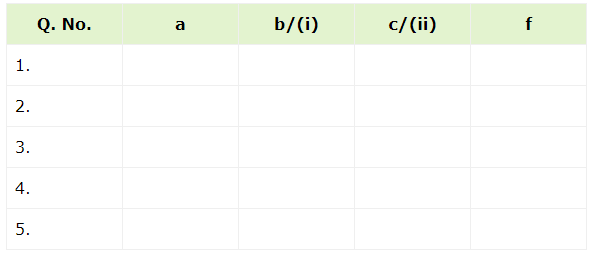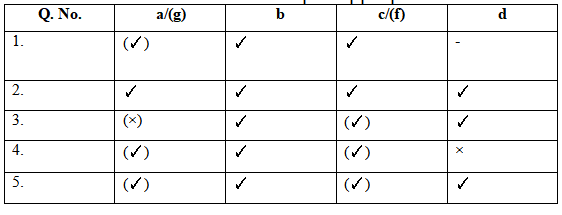Introduction: Decision Making | General Intelligence and Reasoning for SSC CGL PDF Download
Reasoning - Decision Making
Introduction: Decision-making is a process that involves deriving a final outcome by analyzing given data. Specific rules are outlined as selection criteria, followed by the qualification of the candidate. The selection procedure is governed by two conditions:
- Primary Condition
- Additional Condition

In decision-making questions, the following elements are typically present:
- Information about a candidate is provided.
- Conditions are specified that a candidate must fulfill to be selected for a particular job or post.
- If a candidate fulfills many criteria except some, an alternative course of action must be considered.
Primary Conditions and Additional Conditions: In this type of question, there are conditions a candidate must fulfill to be selected for a specific job, termed as Original or Primary conditions. Additionally, there may be further conditions referred to as Additional conditions. These conditions collectively determine the candidate's eligibility for the role or position.
Suggested Methods
To solve this type of questions, little logic is required. All you have to do is to see the candidate fulfils some of the given conditions to decide the correct choice. Taking into account various aspects of this problem, a method is suggested below.
These types of problems can be solved easily by constructing a table using the given information.
Step I − First of all write the symbols of primary conditions (Say a, b, c, d etc.) and additional conditions (Say i, ii, iii etc.) to the top row of the table. Then write the question number and the name of candidates to the extreme left column of table. Put the primary conditions without brackets and the additional conditions within brackets.
Again, write the symbols of additional conditions with an oblique (/) mark placed before them. Then next to the symbol of that primary condition with which these might be related. Suppose we have 5 questions and 4 primary conditions and two additional conditions, then we have to construct a table as following,
Step II − In this step, read each question carefully and compare the facts given in it with various conditions one by one. Put the appropriate mark {‘✓’, or ‘×’ or ‘(✓)’ or ‘(×)’, as suitable}.
In the process of comparing and putting appropriate marks below the conditions indicates the following;
If a primary condition is satisfied, put a ‘✓’ mark below it.
If a primary condition is violated, put a ‘×’ mark below it.
If a primary condition is violated but there exist additional conditions attached to it, then if additional condition is also violated, put a ‘(×)’ mark below it, and if additional condition is satisfied put a ‘(✓)’ mark below it.
When no information is given then put a ‘?’ or ‘-‘ mark below it.
Step III − Now select your answer according to following rule.
Whenever you obtain a ‘×’ and a ‘(×)’ sign do not bother to examine the remaining conditions. Select the choice candidate not selected and move over to next question.
If there is no cross but a ‘?’ mark or ‘-’ mark below any condition, select the choice data is inadequate”. This is called inadequacy of data.
If there are no marks present, then look carefully at the answer and decide which combination of conditions lead to which conclusion and prepare a combination chart as discussed in the illustrative example given below.
Illustrative Examples
Study the following information carefully and answer the questions based on it. The following are the conditions for the requirement of person as faculty members in a computer education centre. The candidate must
a. Be in the range of 23 years to 28 years as on 1 November, 1993.
b. Have work experience- or programming experience.
c. Have a postgraduate degree in computer application. I.e. MCA, M.Tech etc. with at least 60% of marks.
d. Obtain at least 25 marks in the interview out of a total of 50 marks.
In case of a candidate who
e. Fulfils the above criteria, he or she shall be appointed as senior faculty member.
f. Has a post graduate degree in computer application with less than 60% marks but 50% marks, he/she should be appointed as junior faculty member.
g. Is of age more than 28 years but less than 32 years as on 1 Nov., 1993, in case may be referred to director of centre.
On the above condition and the information provided, we have to decide which of the following courses of action should be taken against each candidate. Don’t assume anything. The decisions will be made only on the information provided.
Mark answer
(1) If the candidate is to be selected as junior faculty member.
(2) If the candidate is to be selected as senior faculty member.
(3) If the case is to be referred to the director of the centre.
(4) If data is inadequate.
(5) If candidate is not to be selected.
Questions:
Q1: Manisha Punjabi is M.Sc. in computer science with 65% of marks. Her date of birth is 31st July, 1965. She has been working in an institution as a programmer for last 4 years.
Q2: Kishore Garg is MCA with 61% marks. His date of birth is 14 August, 1970. He has worked as a computer teacher for 3 years. He has obtained 60% marks in the interview.
Q3: Babli Sarkar is M.Tech with 58% marks. Her date of birth is 31st December, 1971. She has been working as a programmer for last two-and-half years. She has obtained 40 marks in an interview.
Q4: Manish Kumar is M.Sc. with 52% marks. His date of birth is 10 July, 1968. He has been working as computer teacher for 4 years. He has obtained 40% mark in interview.
Q5: Sudha Ranjan is MCA with 56% marks. She has been working as a programmer for 3 years. Her date of birth is 12 February, 1969. She has obtained 55% mark in interview.
Solutions:
Step I − There are 4 primary conditions ‘a’, ‘b’, ‘c’ and ‘d’, and two additional conditions are ‘f’ and ‘g’.

Step II − Read each question carefully and compare facts given in it with the various conditions and put appropriate mark below.
Q1 − Manisha is a M.Sc. student with 65% marks. This fulfils condition c. Condition a is violated though on 31st July, 1993, she is more than 28 years. Additional condition of a is g. g is satisfied, that’s why we put ‘(✓)’ mark here. Manisha has more than 2 years of experience. So we put ✓ mark below condition b. Below condition d we can see the vacant space. So we refer to d in the question. Information about Manisha’s mark in interview is missing so we put ‘-‘ mark there.
Q2 − Kishore Garg is an MCA with 61% marks. It fulfils condition c, so we put a ✓ mark below c. According to his date of birth, he will be slightly more than 23 years. So it fulfils a. We put a ✓ mark below a. He has a work experience of more than 3 years. So it fulfils b. He acquired 60% marks in interview that fulfils d.
Q3 − Babli Sarkar is an M.Tech with 58% marks so it violates c. An additional condition is attached to c, is f. Referring to f, we see that f is satisfied. So, we put ‘(✓)’ mark over there. She is certainly below 23 as her date of birth is in 1971. This violates condition a. The additional condition attached to a is g. so g is also violated. We put a (×) mark there.
Q4 − Manish is M.Sc. with 52% marks. So it violates c but fulfils the additional condition f attached to c. We put (✓) mark there. He is born in 1968, so he is nearly 25 years. Hence a is satisfied. We put ✓ mark below a. He worked as computer teacher for 4 years. So it fulfils condition b. Marks obtained in the interview is 40%. It violates d. so we put × mark below d.
Q5 − Sudha is an MCA with 56% marks. This violates condition c but fulfils f. We put a (✓) mark there. She has an experience of 3 years. It fulfils condition b. She was born in 1969, so she is 24 years old. So, condition a is satisfied. She has obtained more than 50% mark. So, condition d is satisfied.
Step IV − Now we have to decide which combination of conditions leads to which conclusion and the following are the conditions.
a + b + c + d ⇒ (2) (senior faculty member)
g + b + c + d ⇒ (3) (to be referred to director)
a + b + f + d ⇒ (1) (junior faculty member)
Q1 − No cross mark and question mark; so, data inadequate.
Q2 − a + b + c + d ⇒ 2
Q3 − A cross-mark is there. So not selected.
Q4 − Answer choice: 5.
Q5 − a + b + f + d ⇒ 1
Solved Examples
Following are the criteria for selection of chemistry lectures in an organization. The candidate must have−
a. Have passed +2 examination in first class with at least 60% marks.
b. Have passed graduation with chemistry honours or pass degree with at least 55% marks.
c. Have experience in chemistry teaching for a minimum of 1 year.
d. Be not less than 22 years and not more than 30 years of age as on 1.1.2014.
If a candidate satisfies all the above mentioned criteria except
I. (b) Above but has a post-graduate degree in chemistry, case may be assigned to the executive director(ED).
II. (c) Above but can has experience and can do marketing, the case may be assigned to the vice president (VP).
Q1: Sambhrant has completed +2 from BJB junior college with 65% marks and graduated in chemistry from Utkal University with 70%. He has teaching experience in chemistry for more than 3 years and his age is 27 years.
(a) If the candidate is to be selected.
(b) If the case is to be assigned to ED.
(c) If the case is to be assigned to VP.
(d) If the information given is inadequate to answer.
Ans: (a)
Sambhrant will be selected as he has all the required qualifications.
Following are the criteria for selection of chemistry lectures in an organization. The candidate must have −
a. Have passed +2 examination in first class with at least 60% marks.
b. Have passed graduation with chemistry honours or pass degree with at least 55% marks.
c. Have experience in chemistry teaching for a minimum of 1 year.
d. Be not less than 22 years and not more than 30 years of age as on 1.1.2014.
If a candidate satisfies all the above mentioned criteria except
I. (b) Above but has a post-graduate degree in chemistry, case may be assigned to the executive director(ED).
II. (c) Above but can has experience and can do marketing, the case may be assigned to the vice president (VP).
Q2: Laxmi Rattan Shukla has passed +2 with 70% marks and is a chemistry graduate with 50% and he has also done M SC in chemistry. He has experience of teaching for more than 1 year and is 29 years of age.
(a) If the candidate is to be selected.
(b) If the case is to be assigned to ED.
(c) If the case is to be assigned to VP.
(d) If the information given is inadequate to answer.
Ans: (b)
This case will be assigned to executive director of the institute because some points related to Mr. Shukla is confusing.
Following are the criteria for selection of chemistry lectures in an organization. The candidate must have −
a. Have passed +2 examination in first class with at least 60% marks.
b. Have passed graduation with chemistry honours or pass degree with at least 55% marks.
c. Have experience in chemistry teaching for a minimum of 1 year.
d. Be not less than 22 years and not more than 30 years of age as on 1.1.2014.
If a candidate satisfies all the above mentioned criteria except
I. (b) Above but has a post-graduate degree in chemistry, case may be assigned to the executive director(ED).
II. (c) Above but can has experience and can do marketing, the case may be assigned to the vice president (VP).
Q3: Mamta Kulkarni is a BSc chemistry student with 53% marks. She has secured 58% in the +2 but has teaching experience of 2 years. She is 28 years of age.
(a) If the candidate is to be selected.
(b) If the case is to be assigned to ED.
(c) If the case is to be assigned to VP.
(d) If the candidate is not to be selected.
Ans: (d)
The candidate will not be selected because Miss Mamta doesn’t satisfy the criteria.
Following are the criteria for selection of chemistry lectures in an organization. The candidate must have −
a. Have passed +2 examination in first class with at least 60% marks.
b. Have passed graduation with chemistry honours or pass degree with at least 55% marks.
c. Have experience in chemistry teaching for a minimum of 1 year.
d. Be not less than 22 years and not more than 30 years of age as on 1.1.2014.
If a candidate satisfies all the above mentioned criteria except
I. (b) Above but has a post-graduate degree in chemistry, case may be assigned to the executive director(ED).
II. (c) Above but can has experience and can do marketing, the case may be assigned to the vice president (VP).
Q4: Ritu Chandra is a chemistry graduate. He has no experience in teaching but he can do marketing for the institute. He has experience in marketing. His age is around 26 years.
(a) If the candidate is to be selected.
(b) If the case is to be assigned to ED.
(c) If the case is to be assigned to VP.
(d) If the information given is inadequate to answer.
Ans: (c)
This case will be assigned to the vice president of the institute as the candidate is able to do marketing. So option C is correct.
Following are the criteria for selection of chemistry lectures in an organization. The candidate must have −
a. Have passed +2 examination in first class with at least 60% marks.
b. Have passed graduation with chemistry honours or pass degree with at least 55% marks.
c. Have experience in chemistry teaching for a minimum of 1 year.
d. Be not less than 22 years and not more than 30 years of age as on 1.1.2014.
If a candidate satisfies all the above mentioned criteria except
I. (b) Above but has a post-graduate degree in chemistry, case may be assigned to the executive director(ED).
II. (c) Above but can has experience and can do marketing, the case may be assigned to the vice president (VP).
Q5: Mannishree Malhotra is a B.Sc. graduate in chemistry and has scored 65% in his graduation. He has teaching experience of 3 years and his age is not more than 27 years.
(a) If the candidate is to be selected.
(b) If the case is to be assigned to ED.
(c) If the case is to be assigned to VP.
(d) If the information given is inadequate to answer.
Ans: (d)
The data is not sufficient as nothing is mentioned about +2 of Mannishree Malhotra. So option D is correct.
|
175 videos|256 docs|167 tests
|
















